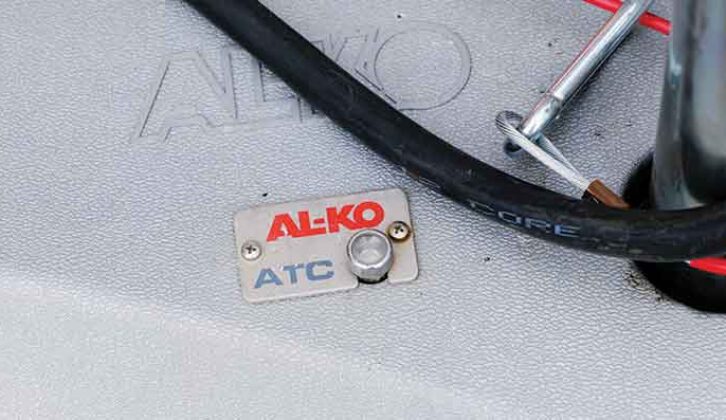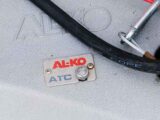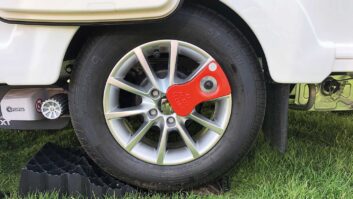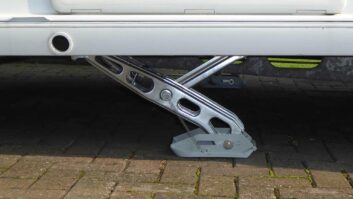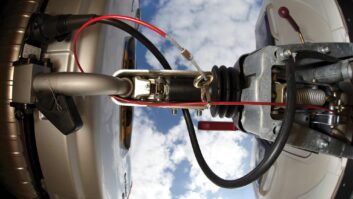I wouldn’t go quite so far as to say that in my case it’s been a lifesaver, but the Al-Ko Trailer Control (ATC) system most definitely saved my caravan holiday, along with a lot of hassle, cost and embarrassment.
We were tootling down the autoroute in France, with our family caravan in tow. Everything felt good and the weather was ideal.
It was almost impossible to tell I was towing, and my speed had crept up to close to the limit.
Then a large panel van whooshed by and the intense blast of air it displaced sent the caravan into a wobble. Normally, this minor instability would settle instantly, but this time, it swayed once, then again more intensely, then back the other way.
This felt different and I knew straight away the caravan was out of control. Suddenly, before there was time to react, there was a ‘graunching’ sound for a second and the caravan jerked backward for a moment. The ATC had activated, applying the caravan brakes automatically, pulling the van straight and back under control. I breathed a huge sigh of relief.
What is ATC on a caravan?
ATC is both simple and brilliant at the same time. It uses smart electronics to sense unwanted movement in the caravan, then instantly applies the tourer’s brakes to pull it straight and back into line.
ATC is an electronic system that fires into life when you connect your tourer’s electric cable to the caravan tow car. You’ll hear a whirr, which is the system self-testing, and then, after a few seconds, the small indicator light on the A-frame should turn from red to green.

Although we would always recommend checking it’s working when you’re preparing your tourer for the new season, ATC is self-managing and requires no maintenance or servicing, once it is active and ‘green lighted’. This really is a fit-and-forget system, there to keep you safe.
In fact, Practical Caravan even gave ATC our Anniversary Award in 2022, calling it “the best innovation in 55 years of caravanning”.
How does ATC work on a caravan?
ATC uses a lateral acceleration sensor to detect any swaying movements on the tourer’s axle, helping you to avoid a snaking caravan. There’s a tolerance range built into the system, which allows for a permissible level of lateral movement. However, the instant this is exceeded, the ATC kicks in and an actuator pushes on the brake rod, which then pulls on the brake cables, causing the Bowden cables to tighten and the wheel brakes to be applied.
This deceleration allows the tow car to pull the caravan back into line, eliminating any sway.

The driver should not brake when the system activates, but instead, should maintain a steady speed to pull the van straight. In reality, ATC acts so quickly that driver reactions will have very little effect on the efforts made by the system to realign the outfit.
The ATC is not affected by the speed of the tow car/caravan combination, and fitting it does not increase the maximum speed limit when towing a caravan of 60mph. ATC cannot be connected to a seven-pin electrics plug.
Understanding the ATC LED display
- Green: ATC active, ready to tow
- Flashing green: ATC self-test. Ready; self-test cancels when towing begins
- Red: ATC is inactive/faulty. You can tow the caravan, but without ATC input. Check the manual to rectify this
- Flashing red: Serious fault. ATC could activate randomly Do not tow!
- No light: ATC not powered-up, or defective. Check the manual to rectify this
If you ever get a non-optimal LED display, start by unplugging the electrics cable and then plugging it back in for a basic reset. This will clear most minor faults.

If that’s unsuccessful, check your plugs or connections for corrosion, and that the towing connection is tight. Poor connections can cause the ATC to switch on and off continuously with the intermittent connection. Ultimately, this will overload the system with error codes. Owners can clear an error code overload by leaving their van connected to a constant power source (a tow car) for 12 hours. Occasionally, tow cars with start-stop functionality can have an adverse effect on ATC.
Generally, an overloaded system locks ‘off’, so you have a usable caravan, but no ATC. If it locks ‘on’, you can try disconnecting and reconnecting the electrics or, worst case, you’ll need a 17mm spanner to uncouple the actuator from the brake rod.

ATC update
Al-Ko has released ATC version 2.0, which is even smarter than the original system and reacts faster to any instability. Version 2.0 also mounts horizontally under the caravan, rather than vertically, which increases its ground clearance and thus minimises the likelihood of impact damage, when, say, driving over a speed bump.
The benefits of ATC 2.0
- Al-Ko’s electronics update delivers more effective stability and safer towing
- Suitable up to a gross weight of 3.5 tonnes
- Optimal weight and design
- Horizontal mounting for freedom of installation space and ground clearance
- Constant control of the caravan’s lateral movements
- System intervenes automatically to establish stable vehicle behaviour
- Acts earlier and more effectively than stabilisation systems in the towing vehicle
Retrofitting ATC 2.0 to your caravan
Many of the best caravans come with ATC as a standard feature nowadays. However, the good news is that if yours doesn’t, a competent DIYer can fit it. Alternatively, engage a qualified technician (we would always recommend AWS-accredited fitters), or you can take it to Al-Ko to fit it.
We visited Out & About Caravan Services in South Lincolnshire, and chatted to expert (AWS) leisure vehicle technician, and co-owner of the business, David Hayes, about the process of installing ATC as a retrofit.
“If you’re happy lying on the floor, you can do it yourself,” says David, “although it’s an awkward fit from that perspective. But what’s really important is buying the correct model. There are twin- and single-axle versions and they come with a range of weight limits.” 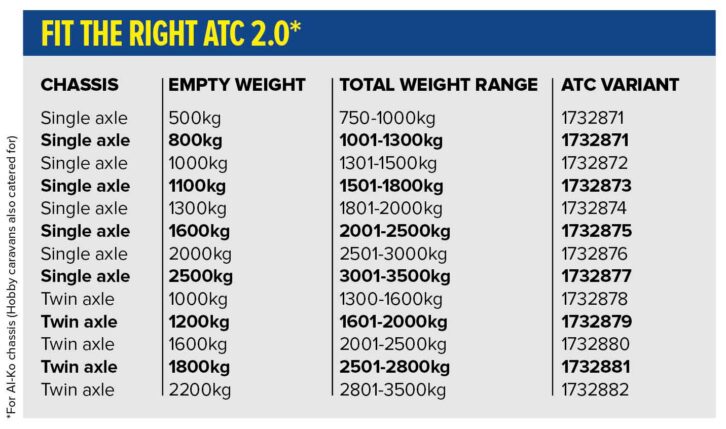
“If your caravan weighs 1800kg (MTPLM),” David says, “You should select the 1501-1800kg model. Don’t think ‘I’ll go one bigger and get the 1801-2000kg model’, as the parameters are set differently and it may not work as well.
“The set-up is quite basic. When you buy a kit, it comes with wiring instructions, and it’s literally plug and play. Bailey even includes the control box and the LED connectors pre-fitted on its later caravans, so there’s no wiring to do. You just mount the unit and fit the LED light and plug them into the system.
“The ATC control unit bolts straight onto two receptor threads located on the bottom of the Al-Ko axle beam, and it’s compatible with almost all Al-Ko chassis.”
Helping your ATC
“Fitting ATC is a great idea for safety-conscious caravanners,” adds David, “but you should do your bit to help the system perform with maximum efficiency. Most caravans are overloaded with possessions, and that doesn’t help the ATC perform optimally. Overloading the gas locker, for example, has a knock-on effect on how the vehicle will handle.
“The distribution of weight is critical, because that’s where the sway starts. Maintenance is also important. Baggy friction pads in the Al-Ko stabiliser don’t help, either, because the caravan’s going to move more. Tighten those by shimming or replacing them, so the stabiliser is effective and aiding the overall stability of the outfit. You can check wear easily by pushing the stabiliser handle down until you feel resistance. Now check the wear arrow. It should be pointing more towards the green line than the red. If it’s on, or close to, the red line, it’s time to change those friction pads.
“In addition, keep your towball clean. It should be silver and free from rust, paint or grease. Use emery cloth or sandpaper to take it down to bare metal, then use a clean
rag and some brake cleaner to remove any final contaminants. Doing this helps the stabiliser to grip better, which will help to minimise any sway.
“Likewise, keep your brakes in optimum condition, as the ATC functions through them. Badly maintained brakes will have a negative effect on ATC.
“People might blame ATC or the stabiliser if their van feels a bit unstable, but they have to play their part, too. Everything needs to work properly for ATC to work most effectively.”
How much is it to fit ATC to a caravan?
ATC costs £600-£800, plus £150-£200 for the installation. You may find slightly better prices online, but we would always recommend using a suitably accredited fitter.
Our thanks to Out & About Caravan Services for its assistance with this feature.
If you’d still like to find out more about ATC, it could be worth embarking on some towing tuition – when I spent the day on the Confidence Builder course, they explained how it works, as well as other aspects that are important to staying safe on the road.
Don’t miss what I have to say about towing electrics either; they play a vital role in ensuring you’re safe and legal when you’re on the road.
Future Publishing Limited, the publisher of Practical Caravan, provides the information in this article in good faith and makes no representation as to its completeness or accuracy. Individuals carrying out the instructions do so at their own risk and must exercise their independent judgement in determining the appropriateness of the advice to their circumstances and skill level. Individuals should take appropriate safety precautions and be aware of the risk of electrocution when dealing with electrical products. To the fullest extent permitted by law, neither Future nor its employees or agents shall have any liability in connection with the use of this information. You should check that any van warranty will not be affected before proceeding with DIY projects.
If you’ve enjoyed reading this article, why not get the latest news, reviews and features delivered direct to your door or inbox every month. Take advantage of our brilliant Practical Caravan magazine SUBSCRIBERS’ OFFER and SIGN UP TO OUR NEWSLETTER for regular weekly updates on all things caravan related.



